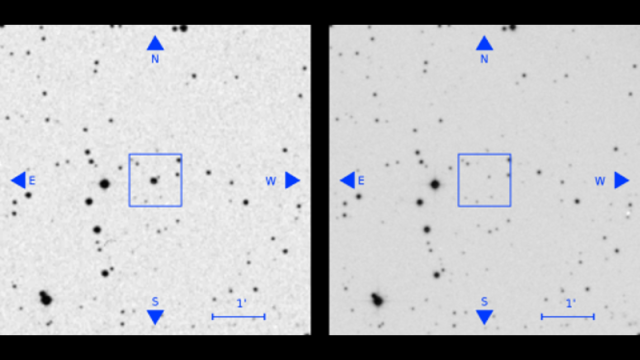A comparative analysis of historical and contemporary astronomical data has resulted in the discovery of approximately 100 star-like objects that unexpectedly vanished. These strange occurrences are likely natural, but scientists say alien technology is a remote possibility.
They start off as dim red dots in the night sky. But then they start to get brighter—anywhere from several to thousands of times brighter. And then they disappear, vanishing from sight in typically less than an hour.
But what are they?
New research published in the Astronomical Journal calls them “red transients,” of which roughly 100 have been chronicled by the authors, a team led by Beatriz Villarroel from Stockholm University and the Institute of Astrophysics of Canarias in Spain. More colloquially, they’re referred to as “vanishing stars,” and they’re baffling scientists.
The red transients were detected thanks to Vanishing & Appearing Sources during a Century of Observations (VASCO)—a project that’s living up to its name. Established in 2017, VASCO researchers are hunting for objects outside of Earth’s immediate area that have mysteriously disappeared. As the authors note in the study:
Unless a star collapses directly into a black hole, there is no known physical process by which it could physically vanish. If such examples exist this makes it interesting for searches for new exotic phenomena or even signs of technologically advanced civilizations.
For the latest research, Villarroel and her colleagues looked at archival astronomical data collected during the previous century, particularly data found in the U.S. Naval Observatory Catalogue (USNO). This old data was then compared to modern celestial catalogues, including the recently concluded Pan-STARRS Data Release-1 (DR1).
From a pool of 600 million objects, the scientists found 151,193 that weren’t represented in the modern catalogues. To date, Villarroel and her colleagues have only had a chance to analyse 23,667 of these anomalous objects, or just 15.7 per cent. Taking this preliminary sample set aside and studying them closer, the researchers found most of them to be “artifacts of various sorts,” wrote the authors, such as smudges on lenses and other visual defects.
But roughly 100 of these objects could not easily be explained away, warranting their designation as red transients. These objects tended to be very red and made distinguishing movements across the field of view, namely larger proper motions than typical objects in the USNO catalogue. Known celestial phenomena, such as asteroids, fast-moving stars, or stars that have simply moved away from view, were ruled out as possibilities.
Now, stars don’t just up and disappear without a trace. Stars, of course, eventually burn out, but they tend to expire in one of two ways, either retiring as white dwarfs or going out with a tremendous bang in the form of a supernova. Another possibility—although a theoretical one at that—is for a star to fall into a black hole, in what astronomers refer to as a failed supernova.
In the new study, the researchers didn’t completely rule out the possibility that supernovae were to blame, saying further research is needed to be sure. As for failed supernovae, they’re expected to be exceptionally rare, and the authors “demonstrate with theoretical calculations that one is not likely to encounter a failed supernova in the VASCO searches,” as they wrote in the study. Another possibility not ruled out by the scientists is that the transient flashes of light are massive solar flares emanating from red dwarfs, among other natural possibilities.
Fascinatingly, the researchers devoted significant space in the new study for a more radical possibility: the activities of extraterrestrial intelligence (ETI). Of course, invoking the alien card is often a good sign that scientists are flummoxed—something seen repeatedly over the course of astronomical history. But that doesn’t mean they should refrain from raising this possibility, and this case is no exception.
As the authors speculate, the dots of red light could be powerful lasers used for interstellar communication or heat waste emanating from Dyson spheres—hypothetical megastructures that envelop entire stars.
Interestingly, VASCO started off as a kind of SETI side project, that is, searching for weird stuff in space that can’t otherwise be explained as originating from natural phenomenon.
“But we are clear that none of these events have shown any direct signs of being ETI,” said Martin López Corredoira, a co-author of the paper, in a press release. “We believe that they are natural, if somewhat extreme, astrophysical sources.”
A thorough follow-up study of these red transients is warranted, according to the authors, who added that their investigation into all 151,193 objects still needs to be concluded. To that end, they hope to recruit artificial intelligence to speed up the process and also arrange a citizen science project.
